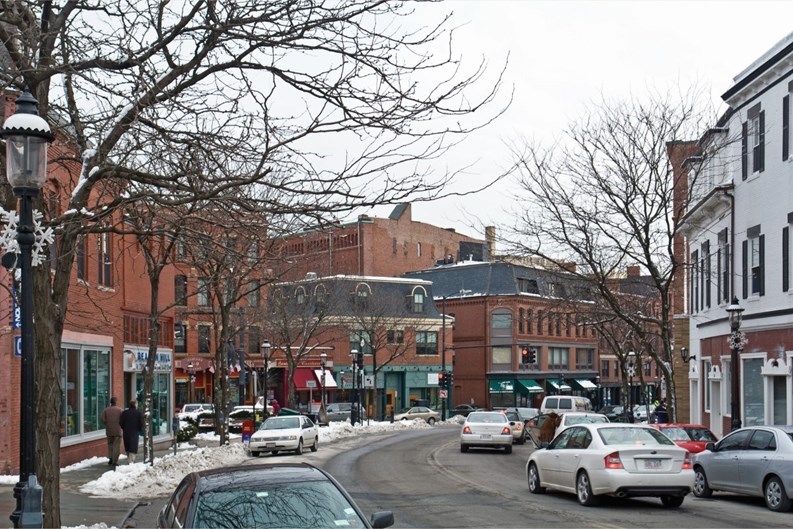Nestled within the fold of Boston but fiercely claiming its independence for over 300 years lies Brookline, Massachusetts. This small portion of Norfolk County is as steeped in history as its populous (and popular) metropolitan neighbor, but has managed to maintain its own identity and carve out a unique place for itself in mélange that is the northeast.
These days, Brookline is enticing savvy residents with its history, its green spaces, its prime location, and the special distinction that comes with boasting a Brookline address on your driver's license.
Sanctuary for the Rich and Famous
Brookline got its name from the two small rivers that mark the northern and southern borders of the town when it was incorporated in 1705. In the 1870s, the city of Brighton merged with Bostonand the Boston-Brookline border was redrawn to connect the Back Bay with Allston-Brighton. This effectively cut off Brookline from the shore, while another isolating move for the area took place twenty years later when the Brookline-Boston annexation debate in 1873 was decided in Brookline's favor, granting it independence from the city of Boston, though it remained smack dab in the middle of it.
Brookline still has one of the highest property tax burdens in the country and was called "the richest town in America" back in the 19th century. The elite of Boston built summer homes in Brook-line—America's oldest country club (appropriately named "The Country Club") is here. When you look at the geography, it's easy to see that Brooklinewas specifically engineered to be a sanctuary for the wealthy at the time.
John F. Kennedy was born in Brookline in 1917, and other notable residents have included Conan O'Brien, novelist Saul Bellow, and members of theWeld family. From the start, Brookline has had a fairly polished reputation.
The Nuts and Bolts
It's also been a D.I.Y. kind of town (i.e., refusing to be incorporated by Boston) and the neighborhood organizations in place certainly reflect the amount of interest community members take in their home. Says Greer Hardwicke of the Brookline Preservation Commission, "If you want to get involved here in politicsor community groups, that's very easy to do and it's encouraged."
Sean Lynn-Jones is co-chair of the Brookline Neighborhood Association (BNA), one such organization. "The BNA is an umbrella group that brings together over twenty neighborhood associations from all over Brookline," says Lynn-Jones. "It holds meetings on topics of interest to neighborhoods, including development, zoning, and neighborhood history, [and] helps neighborhood associations to exchange information on the challenges that confront Brookline's neighborhoods and the strategies that can be effective."
Sharing information in this town-hall kind of way suits the area, since, after all, it's relatively small. "In 2000, Brookline's population was 57,107," Lynn-Jones says. "It probably is between 55,000 and 60,000 now. The town's population peaked at 58,886 in 1970, so it has been roughly constant for almost 40 years." No great influx of people has changed the landscape of Brookline, largely because there's not that much space for them to claim. The area measures just under 18 square kilometers in total.
Still, those square kilometers are diverse ones when you break up the numbers. "Brookline is a diverse community that includes families, young single people, retirees, and students," Lynn-Jones says. "In 2000, only 21.9 percent of the households were families with children under 18. Just under half of all households were married couples and 36.7 percent were single-person households. Many residents are professionals who work downtown, in Boston's medical institutions, or in nearby universities. Although over 80 percent of Brookline's residents are white, there is a fast-growing Asian community that is close to 15 percent of the population. Almost 30 percent of the town's residents speak a language other than English—like Chinese, Japanese, or Russian—at home."
A Blend of City and Country
"Brookline appeals to people who want to be close to the city, but want top notch schools, a plethora of parks, and great neighborhoods," says Matt Bless of Vanguard Realty, a residential brokerage handling sales and leasing in Brookline, Brighton, and surrounding communities for the last five years.
Hardwicke agrees, adding that, "The proximity to Boston is definitely an advantage—there's a nice blend of suburban and urban here." She also notes that the "livability" factor is high, what with the accessibility to the Emerald Necklace park spaces (created by the legendary Frederick Law Olmsted, the founder of landscape architecture, in the1890s), the public transit systems, and the general "intimacy" of the area itself.
The mix of suburban and urban is more pronounced than you might think. "Parts of Brookline are very suburban—there is even a working farm in town," says Lynn-Jones. "Some areas feature mansions and estates. The neighborhoods along Beacon Street, around Coolidge Corner, and near Brookline Village tend to have an urban feel, with many apartment and condominium buildings, as well as high-density single- and two-family residential areas. In recent years, new apartment and condominium buildings have been built in the densest Brookline neighborhoods, generating concerns that those areas are losing their character as they become overbuilt. There is not very much vacant build-able land in Brookline, so existing buildings are often torn down to make way for new construction. Brookline consists of many distinct neighborhoods that are experiencing different patterns of growth and development."
One of the most popular neighborhoods in Brookline today is Coolidge Corner, with its many ethnic restaurants and pedestrian-friendly streets. The large Jewish population provides many popular eateries and Devotion Elementary School contributes to the family-friendly atmosphere.
Luke Pecoraro and Casey Hora are the new curators and caretakers of the Brookline Historical Society and love the Coolidge Corner neighborhood and Brookline's proximity to their former life. "Luke and I are both graduatestudents at Boston University. Brookline is just a short walk or T ride away from the BU campus. We love the Coolidge Corner neighborhood—Trader Joe's, Starbucks, Paris Creperie, the Coolidge Corner Theatre, and the parks." Hora also says that if you happen to be on a first date in Brookline, "it might includea visit to Paris Creperie on Harvard Street, for crepes and a smoothie."
Another Brookline neighborhood attractive to visitors and potential homeowners is King's Corner, a "streetcar suburb" like Coolidge Corner, so named because its growth and development was shaped by the use of streetcar lines as a primary means of transportation in years past. King's Corner offers dining, entertainment, and shopping largely geared toward the university students who live in the area. Those looking for a high-end lifestyle can venture to Chestnut Hill, the upscale area with all those mansions. These different neighborhoods provide Brooklineresidents with many different lifestyle options.
"People choose to live in Brookline for lots of different reasons," says Lynn-Jones. "Parts of Brookline offer suburban living minutes from the city. Families are drawn by the reputation of the schools. Brookline's commercial areas are vibrant, convenient, and walkable, with many restaurants and specialty stores. The crime rate tends to be lower than in some adjacent neighborhoods in Boston. The proximity to Boston and Cambridge attracts many residents."
The Residential 411
The good news is that Brookline isn't out of reach—there are affordable units here. The bad news is that if you're looking for co-ops in Brookline, you won't have much to choose from.
"I believe there are two co-op buildingsin Brookline," says Bless. "It's not a popular form of ownership around here. Most of the large apartment and multi family buildings in Brookline have been converted to condos, with a huge conversion spree in the mid '80s. Because most Brookline buyers are unfamiliar with co-op ownership—and many agents, too—I think there is actually a price penalty for identical units that happen to be co-ops rather than condos. I think there is also a general impression is that co-op boards exert too much control over owners and that prospect is unsettling for buyers."
The condo situation is much different, however. "There are more than twice as many condos in Brookline as single family homes," says Bless. "There are 9,456 condos versus 4,447 single family [homes], according to MLS public record data. Apartment rentals are common in unconverted multi-families and buildings."
The average price of a single-bedroom condo or co-op (if you can find one) will come in around $340,000, with two-bedrooms reaching an average of $499,000. Single family homes in Brookline will price in at about $1.45 million.
If you're looking for a blend of city andcountry with some old-school America flavor, Brookline may be a perfect fit.







Leave a Comment